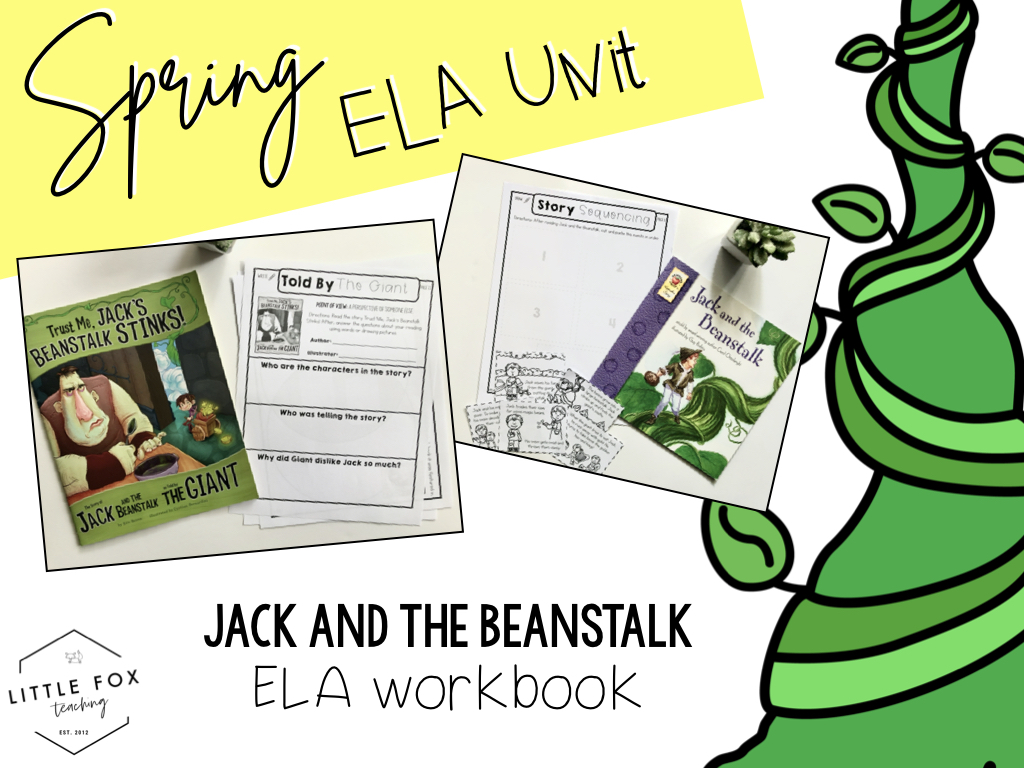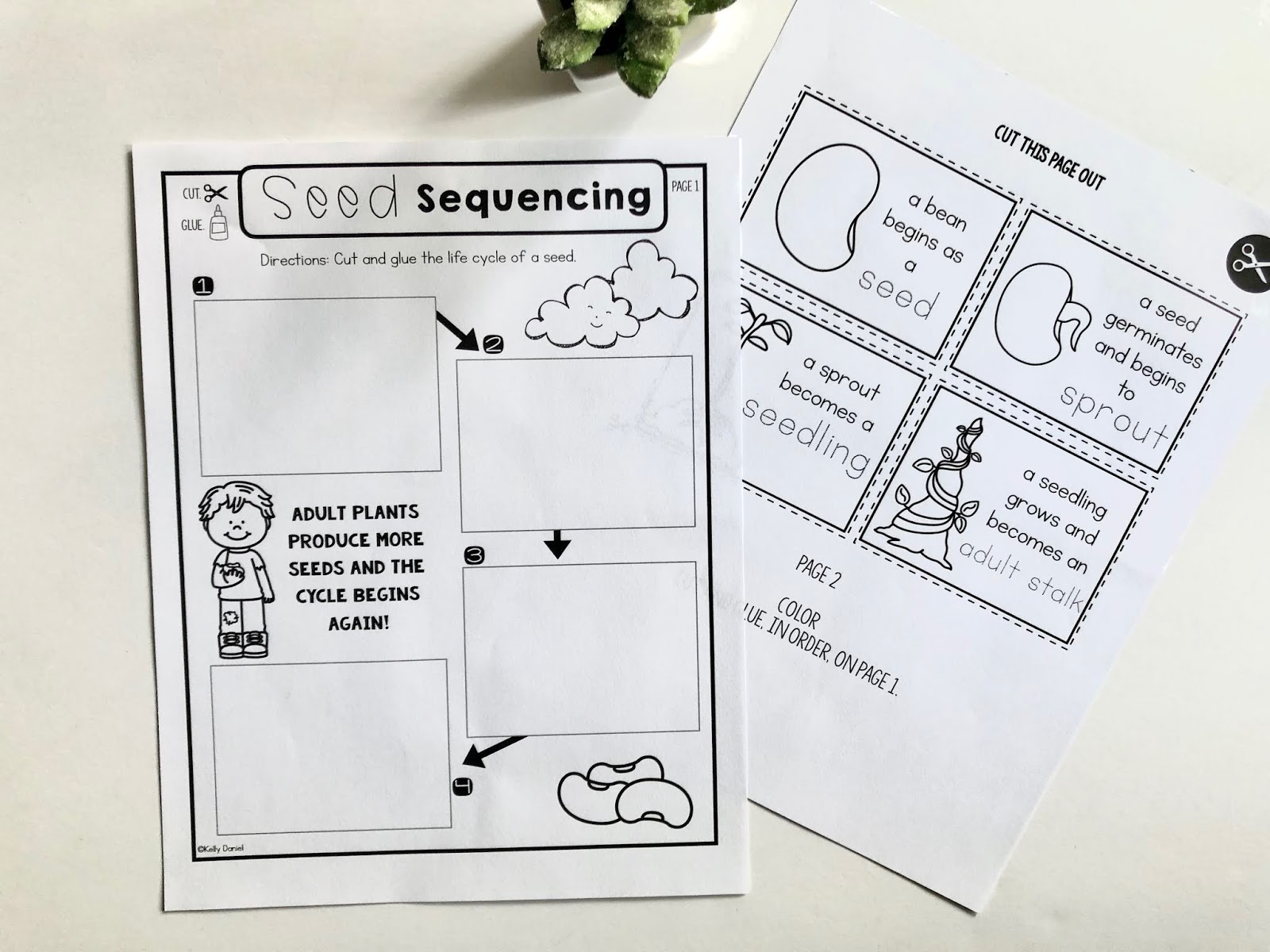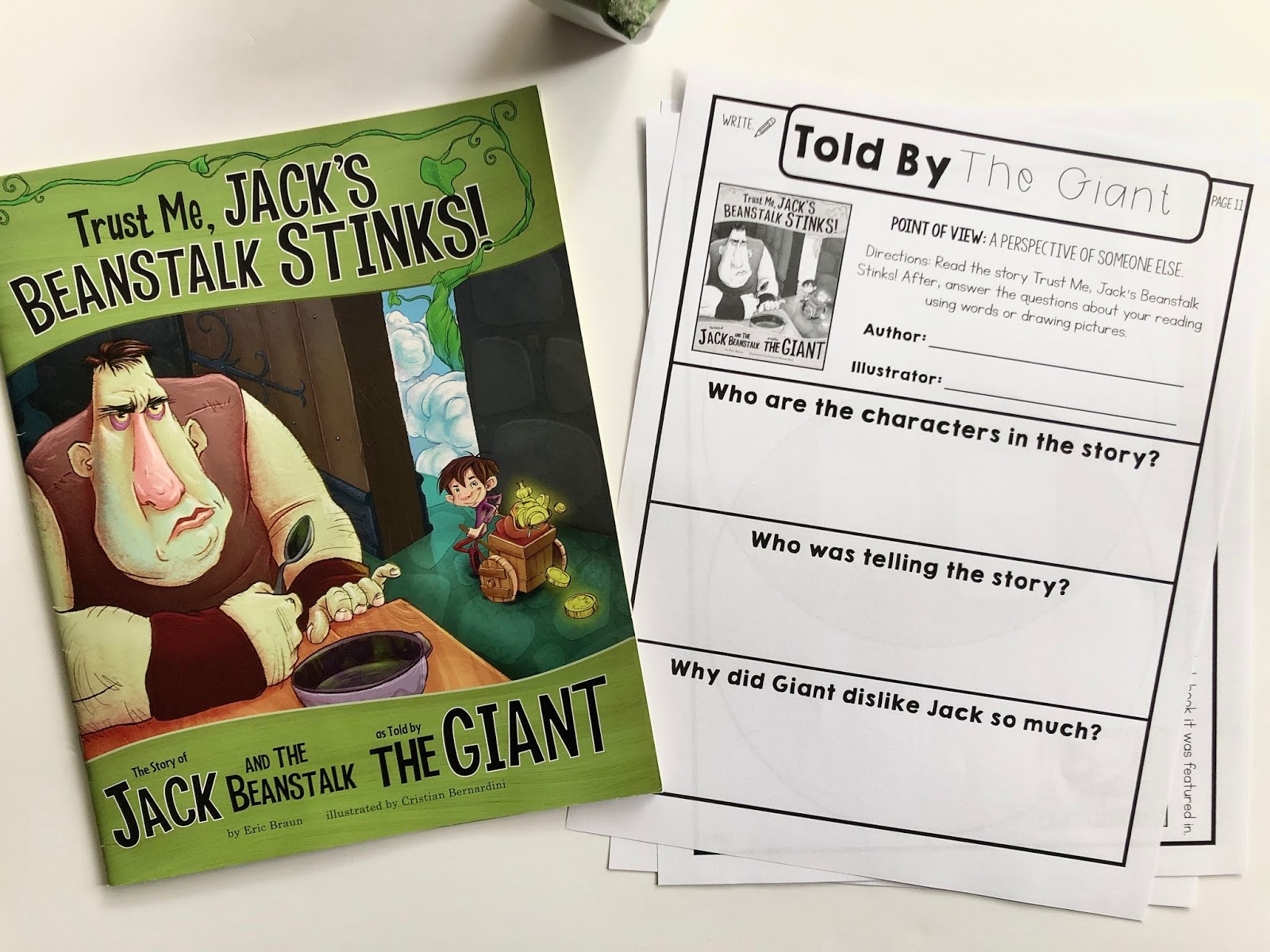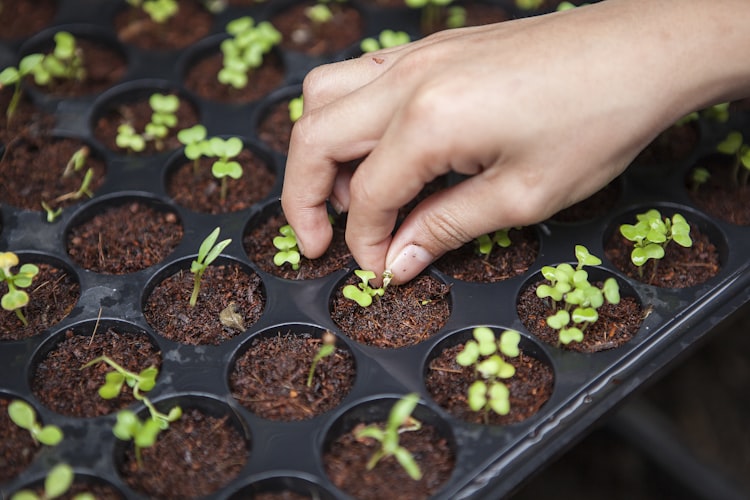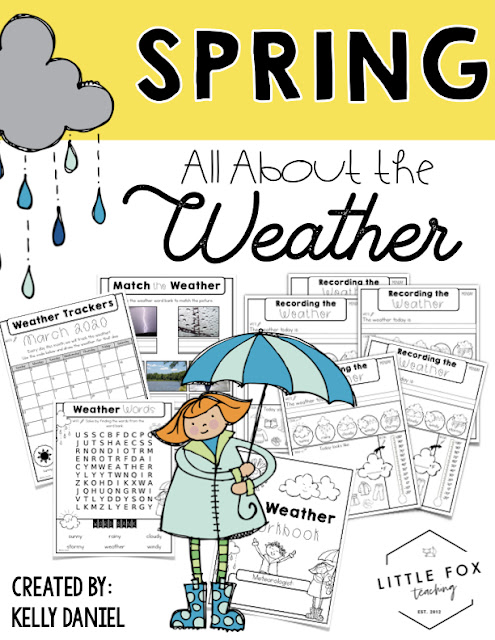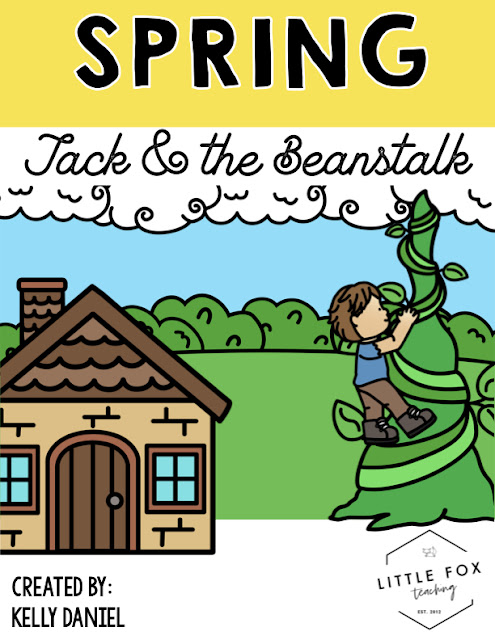March 29, 2020
Jack and the Beanstalk Workbook + Giveaway
Amazon affiliate links may be used within this post.
My kinders and I are heading into our third week of distance learning. It's been a very busy and evolving time as a teacher because I'm having to anticipate what materials to provide and how. I haven't started any live classes yet, but have been providing a schedule and lessons with activities for parents or caregivers to use while at home. Distance learning has been difficult with such a young age group and I'm personally having to do this for the very first time in my career.
With that being said though, the hard work and stress has been worth it because I feel as though I am becoming more resilient as the weeks go on. I'm creating meaningful activities for my students and even though I can't be there with them their parents are sharing so much with me about what's working and what they'd like to see more of.
This coming week we're continuing our unit on Spring with seeds and plants and using the famous fairy tale, Jack and the Beanstalk! This is a great continuation of our unit and this story is a great way to introduce and practice key reading skills like sequencing, the genre of fairy tales, responding to reading, and comparing variations of the same story. It's even a great way to discuss point of view!
Here's a peek at what's included in this Jack and the Beanstalk ELA Workbook!
The OG
We are all familiar with the original fairy tale, Jack and the Beanstalk. It's the story of a young, poor boy who saves his livelihood by venturing up a beanstalk and steals golden items from an unfriendly giant looking to eat him. Of course when you step back and look it's a pretty grisly story, but it lends itself so much to a variety of reading skills and comprehension.There are so many versions of this story (which also makes it a great choice as a mentor text), but I chose the one I readily had on-hand here at home.
Using Shadow Puppet for read alouds.
One app that a colleague of mine shared with me as we began having to teach from home is Seesaw's companion app, Shadow Puppet. It's been a wonderful resource to create my own, simple, read alouds for my students to listen to while at home. It's so easy to use: just snap pictures of each page then open the app and select those photos. You can choose background music (or not) and begin recording your voice as you read. Once you're finished you can share or upload it anywhere! I chose to share mine on YouTube with my students to make it accessible and easy. Feel free to grab the link to these read alouds or make your own!
Sequencing, Sequencing
our reading, even before schools closed, we've been working hard on sequencing. It's a great skill to learn because we sequence so many things in and outside of reading. In math we have ordinal numbers and positions, in science we know seasons are sequenced throughout the year, and so many other examples can be found if you look close enough. So, I love adding a few sequencing activities into my workbooks to keep this skill fresh and allow my students to practice in a variety of ways.Story Sequencing
In our first story, an original retelling of Jack and the Beanstalk, the plot develops in a predictable way. You don't need this specific book, but use one that follows the same events as the original fairy tale. I wanted to keep the sequencing simple since my students will be completing this at home. I chose 5 main events that are key to the original story and made this part a cut, sort, and paste activity.
Students simply cut out the picture cards, color them, then glue them in order from beginning, middle, and end. My students have been working on this since the beginning of our Spring theme, so it's an easy to follow activity that requires minimal assistance from parents at home.
Another great way to sneak in some sequencing is with a seed life cycle sort. My students completed a similar activity in their previous Seeds and Plants workbook from last week, so they should be already familiar with how to do this. What's more, is that this is a great way to connect their learning from science into language arts.
Point of View
Point of view is a complex concept for my kinders to truly understand, but there's no harm in introducing the concept that characters have opinions about other characters. The story, Trust Me, Jack's Beanstalk Stinks by Eric Braun is a wonderful variation on the original story. It is a funny take of the events in Jack and the Beanstalk because it's from the perspective of the Giant!For distance learning, I've uploaded my own read aloud of this story for my students to use during this part of their workbook. Feel free to use it for yourself or your own students! Although I can't be there in person to see my student's get a kick out his version of the story, it's a great read aloud nonetheless to discuss point of view in their reading.
Phonics Practice
Reading these stories have helped my students not only with their reading comprehension, but it's a great story to help with phonics, too! As we continue to learn the alphabet and their sounds, this unit introduces the soft sound of G. It sounds like /j/ like Jack, but words like /g/iant have a different sound! This is an optional activity and is dependent on your grade level. In kindergarten this week, I've planned for our letter of the week to be Jj (to align with our character, Jack) and the phonics practice to be the soft g sound (as seen with the character, Giant). It came together so well!Comparing and Contrasting
Much like in our Winter unit with The Mitten, I love reading variations of the same story and having my students practice comparing the details in each. For Jack and the Beanstalk, students have details and events from the original story and the story as told by the Giant's perspective. We've worked with a Venn Diagram before, too, and it makes another appearance as they sort each event.Creative Writing
I love giving my students the opportunity to work on their writing skills. I've placed a couple of creative writing prompts in this workbook to help kickstart those creative ideas for my students.- What would you find at the top of the beanstalk?
- What would grow if you planted a jellybean?
Before you go, grab this resource for FREE by entering our giveaway! Ends 4/6/2020!
a Rafflecopter giveaway
March 27, 2020
A Seeds/Plants Unit Workbook
It's kind of insane how in just 24 hours everything can change.
One moment my colleagues and I were just beginning the discussion of preparing for distance learning for a few of our students who decided to take precautions and stay home...to...school being shut down until further notice.
Then all of California began to slowly shut down...
...then social distancing turned into shelter-in-place.
Thankfully everyone I personally know, and my own family, are safe from Covid-19. I respect the precautions that our state (and country for that matter) is taking during such an uncertain time. The most all of us can do is to stay indoors for the protection of others. However, being home for the first week with my 4 year old and husband (who is also working from home) has proven interesting.
Nonetheless, my kindergarten team and I have been working tirelessly to create distance learning activities and lessons for our students. It's been a challenging task at times but not because of us putting together our plans, but the roadblocks that come from higher up. However, that's a different conversation for a different day.
Today, I wanted to quickly share out a new workbook that I created for my students while we're away from the classroom. We launched our seeds/plants unit and knowing I (and my students) wouldn't have access to a lot, I created a workbook that includes the activities that we would have covered in class. It's easy prep for parents as the only thing they need is to be able to print and have WiFi to access videos.
Incorporating Seesaw
This week our team expanded the use of Seesaw for students to use to interact more and to share their learning while at home. We informed our student families that not only would we email their weekly lessons and activities, but that additional activities will be uploaded to Seesaw for them to complete. This is a great option for the social interaction, but also for those parents who don't have a printer at home.Seesaw already has an extensive collection of assignments for all grades and creating my own is a breeze. It's been fun to see how my students are engaging with me and the work and I look forward to doing more with them.
For our seed/plant workbook, I periodically upload a page for students to respond to. For example, the first activity is labeling and coloring the part of a seed. I uploaded this page from their workbook and allowed them to snap a photo of their workbook or have the option to complete this part via Seesaw by filling in the blanks right there. I've enjoyed, so far, the capabilities of Seesaw!
Utilizing YouTube
By no means am I a YouTuber or even want to be. I don't like being recorded and I certainly don't like videos of myself. However, in times like these where distance learning is thrown into my lap I have to do what I can to be there for my kids. So, I created a YouTube channel! It's nothing fancy...but it's a platform where I can share my read alouds that I've created using Shadow Puppet.After I create my videos using the app, I simply upload them to YouTube and share the link in my lesson plans to parents. Again, nothing fancy or impressive...just simple videos for the stories I'm using as a part of my seeds/plants unit. You can check a few of them out here:
Guess That Seed!
To make this Seeds & Plants unit a little more fun, I've been rummaging around my kitchen to find different seeds to share with my students on Seesaw. I then upload the pictures as an 'activity' for my students to guess the kind of seed it is. They've come up with so many different, and unique, answers! I like getting a little tougher each week first beginning with the big seed then this last week I found these tiny seeds.
Here's a peek at what I've sent. Can you guess what they are?
The Spring Collection
This seeds/plants workbook is one of a few resources I'm building as a part of my Spring Collection. We began with our unit on weather before jumping into plants and life cycles. I found this to be super helpful in building their schema since weather also operates in a cycle. It also gave my French colleagues time to introduce seeds/plants to them as we purposefully staggered our lessons to complement each other.
March 2, 2020
Wondering About Weather in Kindergarten
Amazon affiliate links are used within this post.
I will earn a small commission on each purchase using my links. Thank you for supporting my blog!
I will earn a small commission on each purchase using my links. Thank you for supporting my blog!
It's March which means we're right on time to celebrate the seasons changing - even if Southern California wants to be stubborn and go back to chilly weather.
Either way, my bilingual students are in for a fun week as we explore all things weather!!
Kicking off our newest unit on weather this week, I've created a wonderful little companion workbook that'll help keep my kids on track and their work safe as we learn all about...
- The job of meteorologist
- The tools meteorologists use to study the weather (with a focus on a thermometer)
- How to record the temperature and reading a thermometer
- The 4 seasons (and sequencing them!)
- Tracking the weather all month long
- Tracking the weather Monday-Friday
- Sorting weather words
- Weather writing prompts, read aloud reflections
- Weather Word Search
- and more!
What is a meteorologist?
In launching our study of the weather it's only right to discuss and introduce my students to the profession of meteorology - both as scientific researchers and news weather reporters. I mean, it all starts here. Next, we'll discuss the tools meteorologists use with a focus on thermometers. They'll learn to read and record the temperature using the practice thermometers in our workbookTracking the weather all month long
I'm excited to tie in a little calendar work with my kinders as we discuss the weather patterns each day. It's a great time to review English vocabulary around days of the week, how to read a calendar, and use a key to record the weather each day. I also can't wait to discuss the word 'predict' and how we can make guesses both in our reading, but also in how we can use clues to predict the weather.
This month long tracker is for March 2020, but I do have an editable section where you can overlay your own calendar to match the month you plan on teaching this unit.
Also, I've included daily recordings where students practice key skills such as sentence writing using weather vocabulary, creating drawings with details to convey a message about the type of weather, demonstrating their understanding of weather patterns and what to wear, and finally how to record the temperature using a thermometer (a link from the beginning of the unit).
The Four Seasons
Although we don't experience the same kind of weather during each season as other places in our country (or around the world), it's a great introduction to students nevertheless! In order to build upon their knowledge later on, I like beginning with seasons and how weather during those seasons look and feel different - and even moreso around the world where there are different climates.
This section is all about introducing my students to the four seasons throughout the year. Key vocabulary include the seasonal words, concepts of a cycle, and tie in their schema about temperature and how that affects the environment during each season. I've created this flip book style page where students cut and glue their flip pages and reveal the trees underneath where they'll fill in the colors associated with the weather during that season.
Thus far in kindergarten we've learned about the desert and the arctic in which we've had in-depth conversations about environmental and animal adaptations. This will be wonderful background knowledge as we discuss a little more about how weather also impacts those habitats and these adaptations. #winwin
Season Sequencing
Students demonstrate their understanding of the four seasons and cycles (lending to our next unit on life cycles!) by cutting and pasting the seasons in order as they happen during the year. I like starting the cycle with Winter since we just wrapped up our themed unit on winter - it only seemed natural. But, feel free to have your students start with whatever season you are in when you're teaching your weather unit.
Drawing the Seasons
In this section I use paint with Q-Tips (or simple markers) for students to draw what each tree looks like during that season. It's a variation of the popular activity and I thought a fun activity to include!
Teacher Tip: Use these plastic containers like these to store paint! Since I travel from class to class, this helps keep the mess to a minimum and allows my students the use of paint for English activities!
Although it makes for a pretty thick packet, I'm super excited to use this as a means to track my student's learning and cut down on the missing papers. Plus, it's flexible in that you can pick and choose what activities you'd like to include in a workbook and which ones you'd prefer to have as individual handouts. Either way, it's going to be a fun week wondering (and thinking!) about weather!
Subscribe to:
Comments (Atom)
Hey there!


